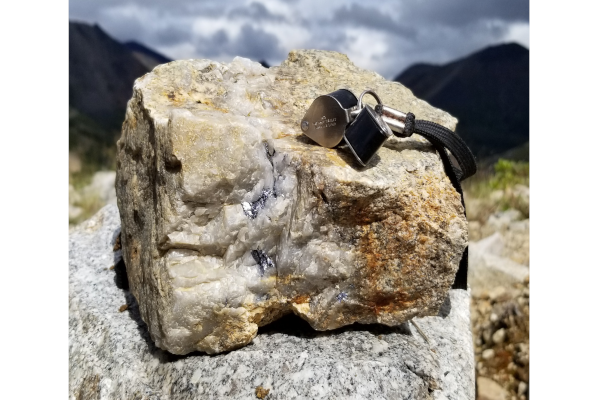In order for steel to be considered stainless, the chromium content must be at least 10.5%, and it is chromium which forms the essential self-healing
passive outer oxide layer which is resistant to harsh corrosive environments from seawater to acids, and across a wide range of temperatures.
By David O’Brien, President & CEO, Stuhini Exploration
In essence, the higher the chromium content, the thicker and more resistant to corrosion this passive oxide layer becomes. Once the 10.5% threshold is broken, general surface corrosion is typically never a problem; pitting corrosion is a far more likely occurrence. This is where molybdenum comes into the picture – it is a key stainless steel alloy that has statistically shown to improve pitting corrosion resistance, and is therefore a major variable in the calculation of the Pitting Resistance Equivalent Number, or PREN.
PREN = %Cr + 3.3x %Mo +16x %N
It is more of a qualitative factor that cannot be used to safely predict absolute performance, but it is useful from a theoretical perspective as a way of comparing pitting resistance of different compositions of metal. So, if increasing molybdenum content can quickly increase the performance of a given alloy – why is this practice not more widely followed?
Simply because molybdenum is typically three to four times higher in cost than chromium.
Looking at Molybdenum demand, about 24% of molybdenum production from mined ore is used for the production of molybdenum grade stainless steel, which is the second highest use for the often-underappreciated alloy after engineering steels which account for 39% of demand. The balance of demand comes from tool steel, cast iron, nickel alloys, as well as chemical compounds and lubricants.

Green Energy Applications
There is also new demand forming from the so-called Green Energy Economy as applications from windmill technology to hydrogen conversion require molybdenum. The world bank recently stated: “Molybdenum and copper, for instance, are used in more than eight clean energy generation and storage technologies; thus, even if technological improvements, costs reductions, and deployment of new emerging technologies were to take place, these changes would have little impact on the overall demand for them.”
The International Molybdenum Association (IMOA), headquartered in London and headed by Eva Model, is a pro-grade organization representing all that is Molybdenum, with membership ranging from producers and explorers to end users. Recently published numbers from the IMOA indicate falling global production and increasing usage – figures release for Q1 of 2022 indicate that global production fell by 4% to 138.4 million lbs when compared to the previous quarter. When comparing to Q1 of 2021 production fell by 7%. At the same time, global usage increased 7% when compared to the previous quarter, although usage did decrease by 2% when compared the same quarter for 2021. Interestingly, China remained the largest molybdenum producer at 57 million lbs or 42% of production.
U.S. President Biden wants to reduce both the global, and U.S., dependence on China for both base and so called “strategic metals” going forward, yet western populist movement is very anti-mining at present, which is creating an interesting dilemma as follows: We all want a greener less hydrocarbon dependent future, but this future calls for a significant increase in metal demand, which in turns call for more mining. This demand curve coupled with the lack of investment in the sector might create a similar scenario in the metals markets that occurred in the early 2000s, as China began to emerge as an industrial power – metal prices had to have a disruptive upward price movement in order to allow the explorers and developers to move forward with their projects. As the old saying goes: the solution to low resource prices is low resource prices.

Overall Market Overview
Moving back to the molybdenum market, it is quite an unusual market as over 80% of current molybdenum production is a by-product, typically from Copper mining. The less than 20% pure-play molybdenum production is dominated by Freeport McMoRan and with their Climax and Henderson projects in Colorado.
According to the CPM group out of New York, this has the potential to be disruptive since molybdenum production is not based to a large degree on molybdenum demand, but moreso by Copper demand. Additionally, the next generation of Copper mines are lower grade and do not particularly have the molybdenum by-product compared to the presently producing mines, that for the most part have dwindling reserves and low reserve life indexes. Andrew Zemek of the CPM group has stated that we will soon have to move to pure-play molybdenum projects and outside of China – there are very few of these in existence, let alone ready for advancement towards production. Additionally, the handful of these large projects that are sitting in waiting are not able to presently attract adequate financing to move them forward.

Conclusion
Whether lightweight engineering steel, corrosion resistant high-quality stainless steel, harder steel or steel that can withstand higher temperatures is wanted, molybdenum can be a key additive for which there are no viable substitutes. Often overlooked and underappreciated, it appears molybdenum will play an even larger role going forward as there is transition to a greener, less hydrocarbon dependent economy. Yet, due to the underappreciation of most metals by the investing public coupled with a growing anti-mining sentiment worldwide – nearer term future supply appears in doubt, therefore something will have to give.
References
- https://www.langleyalloys.com/2022/08/23/molybdenum-improving-corrosion-resistance/
- https://www.mining.com/web/demand-for-steel-alloys-grows-as-the-energy-transition-gains-momentum/


